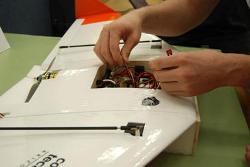Mar 26 2010
Students in ASU's College of Technology and Innovation at the Polytechnic campus are building more than toys for their capstone projects.
 An Engineering Technology student makes a few last minute adjustments to the video camera component before his capstone project team’s unmanned aerial vehicle takes flight
An Engineering Technology student makes a few last minute adjustments to the video camera component before his capstone project team’s unmanned aerial vehicle takes flight
One of the latest projects, a video-capable unmanned aerial vehicle (UAV), could be used for security, search operations, and land and environmental surveying by private and public entities.
A team of eight students has designed and built the UAV with both autopilot and remote control capability. It launches under manual remote control, but once in the air can autonomously follow a route between several waypoints, while streaming video, before returning for a landing.
“With these projects, students are using technology, a little imagination, and off-the-shelf hardware to design and build a small UAV,” said Changho Nam, associate professor in the Department of Engineering Technology. “Through the UAV capstone projects, students acquire the experience of working as part of a team to solve a challenging, practical design and build problem within a limited budget. They have gone through all the steps of designing and building a prototype aircraft, including design, analysis, fabrication and test flights.”
The project builds on similar work done by a student team during the 2008-2009 academic year, added Nam, the team’s faculty adviser.
Jeremiah Gayle, airframe design team lead, said the UAV, which has a wingspan of 4.5 feet and weighs about 4 pounds, embarked on its maiden flight March 11.
“We had to use a larger design than last year’s team in order to support the integrated video system and a heavier battery,” said Gayle, who estimated that the UAV’s battery could support up to half an hour in the air.
The aircraft broadcasts a live video feed from the onboard camera and transmits the video to a ground-control computer system where it can be recorded.
The team considered 15 designs, digitally modeled the top five and tested them for optimal lift and stability before the final design was chosen. Their final product is modular, with wings that can be easily detached from the fuselage. Substituting different wing sets can alter the vehicle’s capabilities to suit a variety of functions.
Gayle said that comparable commercial video-capable aerial systems have applications in security, patrolling remote border areas or even for surveying large farms, and can sell for around $10,000. Construction costs for the students’ UAV came to approximately $2,000.
Gayle, along with teammates Brad Golding, Thomas Gonzales, Kamerine Kroner, Kevin Languell, Gabe McDaniel, Jake McKown and Juan Rios, constructed the UAV using remaining materials from last year’s UAV project, sponsored by Kutta Technologies. About $800 in supplemental funding was provided through the Department of Engineering Technology.
The project has not been without its setbacks though. Interference between the streaming video and the remote piloting signal initially caused the team to lose control of the UAV in flight and a new transmitter had to be installed.
“Computer science is involved in programming the autopilot and troubleshooting after test flights,” said Rios, project manager and autopilot system team lead. “We didn’t have much initial programming experience, so we learned on the go.”
The project has proven inspirational despite difficulties.
“Personally, since getting involved with this project, I’ve become much more interested in UAVs,” Rios said. “This has become something that I’d like to pursue in the future as a career.”
“It’s great to watch something you designed go from a computer model to something you can hold in your hands,” Gayle said.
The students will present their work at the American Institute of Aeronautics and Astronautics Region VI Student Conference, March 25-27, in Tucson.